"Remember, this is the 1950s." That's what I had to remind myself just after skidding halfway into an intersection in a $220,000 hot rod that a Norwegian customer had paid real money for. I'd only taken the wheel 300 feet before and couldn't have been doing 25 miles per hour when I locked up, but that tire-scorching moment taught me exactly what I was driving: an authentic hot rod. Things were a lot different in the '50s. Especially brakes.
Troy Ladd of Hollywood Hot Rods makes the closest thing to the original that I've ever driven. What's more, he builds them like works of art that are composed of individual works of art. But before we delve into the 1932 Ford I drove, we need a quick peek back into history for context.
The hot rod narrative roaring out of a 1980s resurgence behind builders like Boyd Coddington and Pete Santini was big horsepower and lurid paintjobs. The anti-elegance in the rise of rat rods a decade later didn't quell the urge for horsepower – and upgrades like massive rear tires to tame it – nor did the Discovery Channel, its multi-network roof expansive enough to house the Chip Fooses and the ratty packs.
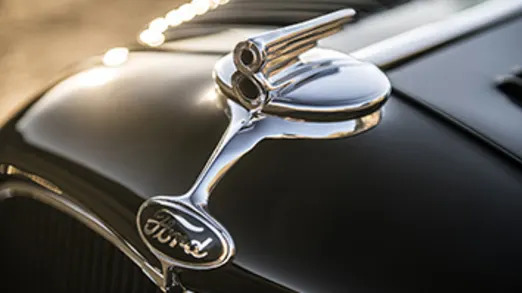
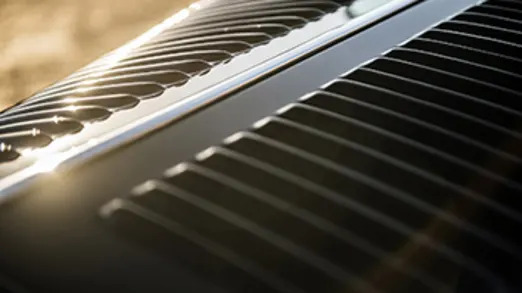
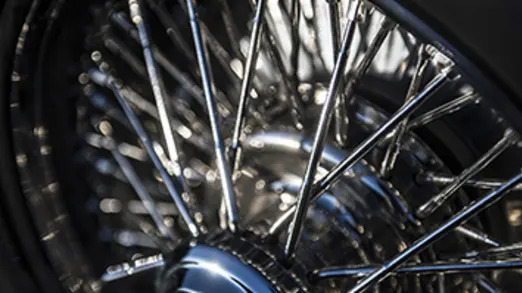

The average rodder, though, didn't have Edelbrock's resources. And if he had a Ford, he didn't have a small block Chevy. But he did have really skinny bias-ply tires, and there are physical limits to how fast you can go even in a straight line when you're relying on six-inch tires.
Performance-wise, Ladd's work at Hollywood Hot Rods sticks to that original spirit, but he spends 12 to 18 months on the details. "There are tons of shops like this one that build shiny cars," Ladd said, "but few have art reflected in the car. Our main focus is metal – every part made for the car has to be art itself, and the chassis is standalone art."
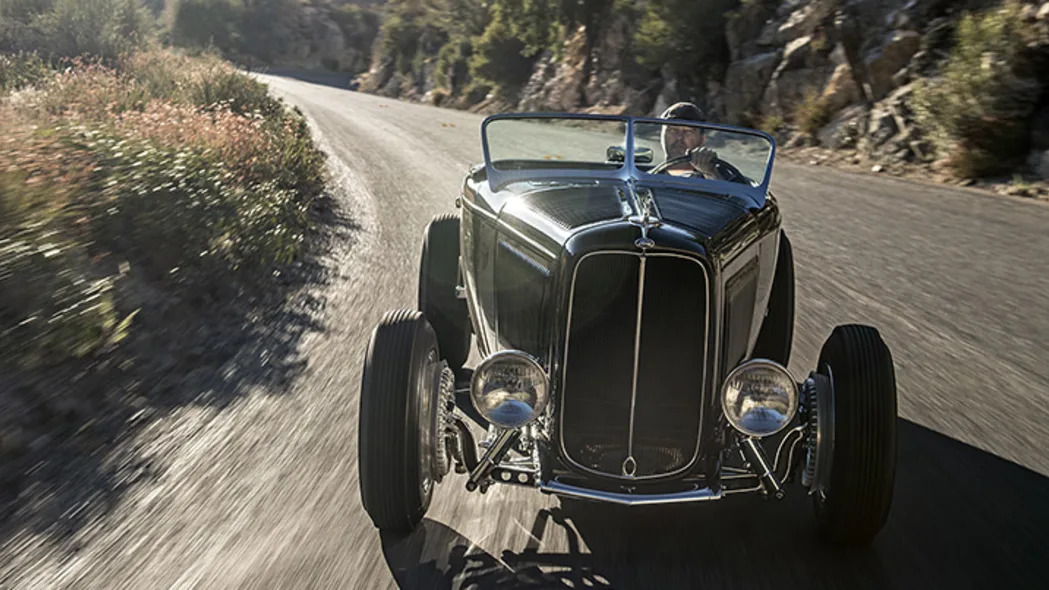
Ladd isn't about getting easy attention with smokestack pipes and tangerine metallic flake. He starts with the best original parts for the job, then hundreds of man-hours subtly reveal themselves in impeccable welds, reshaping work you'd need a Pebble Beach judge to notice, CNC machining, paint jobs that can cost six figures, chrome plating, polished stainless steel, and polished aluminum.
Our tester was an original 1932 Ford – not a reproduction – sitting on chassis members given additional stiffening. We had to get under the car to see that the drilled-and-dropped I-beam frame had been completely chromed, matching the visible hairpin suspension. Above that faint tweaks abound, like the 25-louver engine cover with additional louvers cut into the top, the shaved rear wheel arches to get the back end to sit lower, the lack of a rear spreader bar, and an HHR-fabricated custom vintage racing cap placed atop the rear deck in the middle of the trunk shutline. When we asked Ladd why didn't he move the cap forward to permit a straight trunk edge, he replied, "Because that would have been easy. This way there's one more little artistic detail."
Ladd said there's a wide choice of parts because "I'm not super loyal to brands, the car requires what the car requires. Except small-block Chevy in a Ford. I don't do that, I push people away from that. A Ford is cool, a Chevy in a Ford is not."
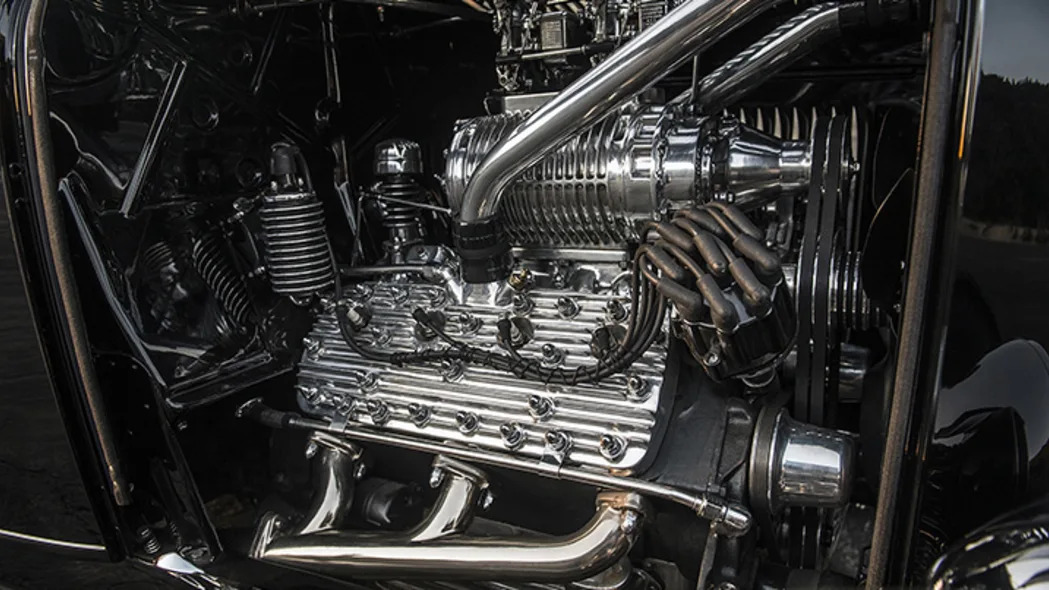
The interior is accessed via suicide doors similar to the '32 Coupe (the '32 Roadster came with traditional doors). The Scandinavian owner collected parts he wanted to ornament his toy, so the gauge cluster comes from a 1932 Lincoln, the faceplate from a vintage heater hangs in the middle of the dash, the shift knob is a tchotchke from the 1938 World's Fair. It works a modern, five-speed Tremec transmission because, said Ladd, "It's got to be fun to drive." The owner took his treat on a tour of America, so Ladd made a custom three-piece luggage set to go in the leather-lined trunk. The straight pane of glass you'd expect to find on the cowl has been replaced by a DuVall V-shaped windshield.
The 16-inch stainless steel wire knockoffs by Dunlop of England exude European flair, shod in Firestone bias-ply tires 5.5 inches across in front, seven inches across in back. Behind them it's back to old-school America, with Buick-finned aluminum drums as anchors.
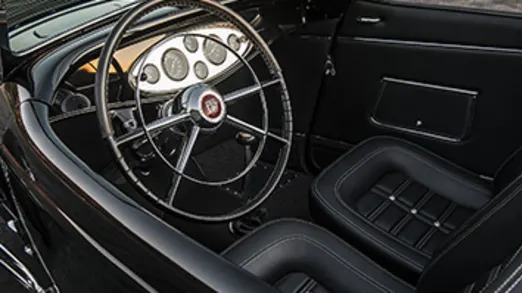
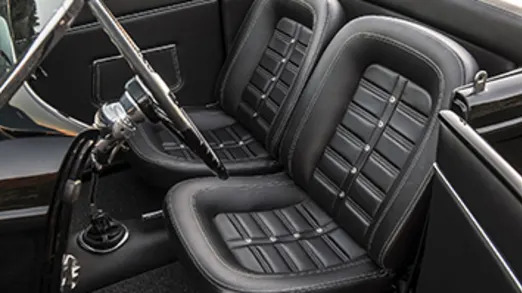
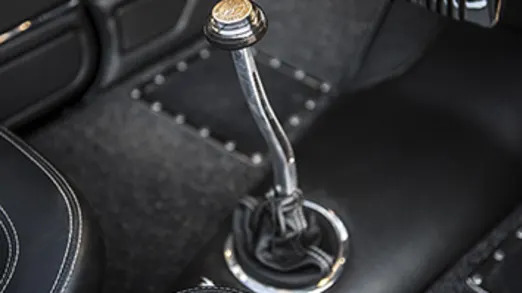

Hence my skid in less than 30 seconds behind the wheel. The whole car weighs 2,000 pounds, which is nothing by modern standards but a surprising sum from the driver's seat. Few cars demonstrate less-is-more in both literal and figurative senses like a hot rod – go any lesser and you're down to three wheels or at a soapbox derby.
Ladd worked with QA1 on a 12-setting shock to set the front end properly according to the weight of the engine. The setup rolled easily over the same Burbank roads that original rodders cruised sixty years ago. Nevertheless, more notable than the suspension behavior was soaking up hot rod vibrations. The whole machine is solid but it shakes, alive with the 220-hp pulses of that Flathead V8. The tire contact patches are tiny, but it takes a heave on that leather-rimmed steering wheel to turn them. The brake and clutch pedals are tiny circles up against either side of the chrome steering column, the accelerator a mere candy bar about six inches to the right. You can rumble away from a stoplight with a smart spurt, but you'd need Bonneville space to work up a real speed lather.

Ladd needs 1.5 years to build such a barely anything, and art is expensive – $100,000 is a starter kit price. The $220,000 MSRP of the hot rod we drove is worth a Lamborghini Huracan LP 580-2 with a few options, but the two aren't remotely comparable. Hollywood Hot Rods delivers what no Lamborghini can: the fifties itself, resonating Hitchcock and Brando and Eisenhower, Peanuts cartoons and Playboy, the space race and the very first McDonald's, and, yes, long braking distances. And I think it's fantastic.
Related Video:
Troy Ladd of Hollywood Hot Rods makes the closest thing to the original that I've ever driven. What's more, he builds them like works of art that are composed of individual works of art. But before we delve into the 1932 Ford I drove, we need a quick peek back into history for context.
The hot rod narrative roaring out of a 1980s resurgence behind builders like Boyd Coddington and Pete Santini was big horsepower and lurid paintjobs. The anti-elegance in the rise of rat rods a decade later didn't quell the urge for horsepower – and upgrades like massive rear tires to tame it – nor did the Discovery Channel, its multi-network roof expansive enough to house the Chip Fooses and the ratty packs.




The homebrew Deuces born in the 1940s and 1950s were nothing like those reality show work-ups. The Ford Flathead V8 first introduced in the 1932 Ford became the ubiquitous post-war hot rod engine because customizers could pick up an entire pre-war Ford in decent condition for $15, and a 1948 Flathead came stock with 100 horsepower. Having valves built into the block complicated power increases, which is why one of the most extreme and expensive upgrades was Ardun heads. Designed by eventual Corvette engineer Zora Arkus-Duntov and his brother Yura, they turned the Flathead V8 into an overhead valve engine with hemispherical combustion chambers, yet added only 50 more horses. Yes, that's a meaty 50-percent jump, but it's also a different engine. At the same time, the Fireball inline-eight in the Buick Roadmaster was putting out 144 hp. It would take six years for Vic Edelbrock, Sr. to make the cover of Hot Rod for coaxing 375 hp out of a 265 Chevy V8." Performance-wise, Ladd's work at Hollywood Hot Rods sticks to that original spirit, but he spends 12 to 18 months on the details. "
The average rodder, though, didn't have Edelbrock's resources. And if he had a Ford, he didn't have a small block Chevy. But he did have really skinny bias-ply tires, and there are physical limits to how fast you can go even in a straight line when you're relying on six-inch tires.
Performance-wise, Ladd's work at Hollywood Hot Rods sticks to that original spirit, but he spends 12 to 18 months on the details. "There are tons of shops like this one that build shiny cars," Ladd said, "but few have art reflected in the car. Our main focus is metal – every part made for the car has to be art itself, and the chassis is standalone art."

Ladd isn't about getting easy attention with smokestack pipes and tangerine metallic flake. He starts with the best original parts for the job, then hundreds of man-hours subtly reveal themselves in impeccable welds, reshaping work you'd need a Pebble Beach judge to notice, CNC machining, paint jobs that can cost six figures, chrome plating, polished stainless steel, and polished aluminum.
Our tester was an original 1932 Ford – not a reproduction – sitting on chassis members given additional stiffening. We had to get under the car to see that the drilled-and-dropped I-beam frame had been completely chromed, matching the visible hairpin suspension. Above that faint tweaks abound, like the 25-louver engine cover with additional louvers cut into the top, the shaved rear wheel arches to get the back end to sit lower, the lack of a rear spreader bar, and an HHR-fabricated custom vintage racing cap placed atop the rear deck in the middle of the trunk shutline. When we asked Ladd why didn't he move the cap forward to permit a straight trunk edge, he replied, "Because that would have been easy. This way there's one more little artistic detail."
Ladd said there's a wide choice of parts because "I'm not super loyal to brands, the car requires what the car requires. Except small-block Chevy in a Ford. I don't do that, I push people away from that. A Ford is cool, a Chevy in a Ford is not."

Under those louvered panels lives a late 1940s, 248-cubic inch Flathead Ford V8 with a balanced, ported, and polished block and Fenton cast iron headers, aided by a SCoT supercharger – the Supercharger Company of Turin made one of the most popular roots-style blowers in the fifties. Dual Stromberg 97 carburetors sheathed in chrome stand atop Navarro finned aluminum heads; Navarro says four out of five hot rod records set at Bonneville were achieved with its heads and manifolds. The engine is immaculate, and we're talking about much more than the absence of dirt. It puts out all of 220 hp."The engine is immaculate, and we're talking about much more than the absence of dirt. It puts out all of 220 hp."
The interior is accessed via suicide doors similar to the '32 Coupe (the '32 Roadster came with traditional doors). The Scandinavian owner collected parts he wanted to ornament his toy, so the gauge cluster comes from a 1932 Lincoln, the faceplate from a vintage heater hangs in the middle of the dash, the shift knob is a tchotchke from the 1938 World's Fair. It works a modern, five-speed Tremec transmission because, said Ladd, "It's got to be fun to drive." The owner took his treat on a tour of America, so Ladd made a custom three-piece luggage set to go in the leather-lined trunk. The straight pane of glass you'd expect to find on the cowl has been replaced by a DuVall V-shaped windshield.
The 16-inch stainless steel wire knockoffs by Dunlop of England exude European flair, shod in Firestone bias-ply tires 5.5 inches across in front, seven inches across in back. Behind them it's back to old-school America, with Buick-finned aluminum drums as anchors.




Hence my skid in less than 30 seconds behind the wheel. The whole car weighs 2,000 pounds, which is nothing by modern standards but a surprising sum from the driver's seat. Few cars demonstrate less-is-more in both literal and figurative senses like a hot rod – go any lesser and you're down to three wheels or at a soapbox derby.
Ladd worked with QA1 on a 12-setting shock to set the front end properly according to the weight of the engine. The setup rolled easily over the same Burbank roads that original rodders cruised sixty years ago. Nevertheless, more notable than the suspension behavior was soaking up hot rod vibrations. The whole machine is solid but it shakes, alive with the 220-hp pulses of that Flathead V8. The tire contact patches are tiny, but it takes a heave on that leather-rimmed steering wheel to turn them. The brake and clutch pedals are tiny circles up against either side of the chrome steering column, the accelerator a mere candy bar about six inches to the right. You can rumble away from a stoplight with a smart spurt, but you'd need Bonneville space to work up a real speed lather.

All of this along with my near mishap taught me that you don't hot-rod in a genuine hot rod, you cruise. A Porsche roadster from the era – or a Miata – wraps its tiny body around you. This is metal bathtub with an engine, perched on two spars and four wheels. Get yourself a lightly trafficked road, put an elbow on the door sill and "Rock Around the Clock" on the radio, and sail on. It's the most uncluttered experience on four wheels, overwhelmed by air and space and the sensation – due to the reality – that there's barely anything beneath you. And a Flathead V8 sounds good, a virtue that will come in handy when you pull up next to girls with names like Peggy or Barbara..."This is metal bathtub with an engine, perched on two spars and four wheels."
Ladd needs 1.5 years to build such a barely anything, and art is expensive – $100,000 is a starter kit price. The $220,000 MSRP of the hot rod we drove is worth a Lamborghini Huracan LP 580-2 with a few options, but the two aren't remotely comparable. Hollywood Hot Rods delivers what no Lamborghini can: the fifties itself, resonating Hitchcock and Brando and Eisenhower, Peanuts cartoons and Playboy, the space race and the very first McDonald's, and, yes, long braking distances. And I think it's fantastic.
Related Video:
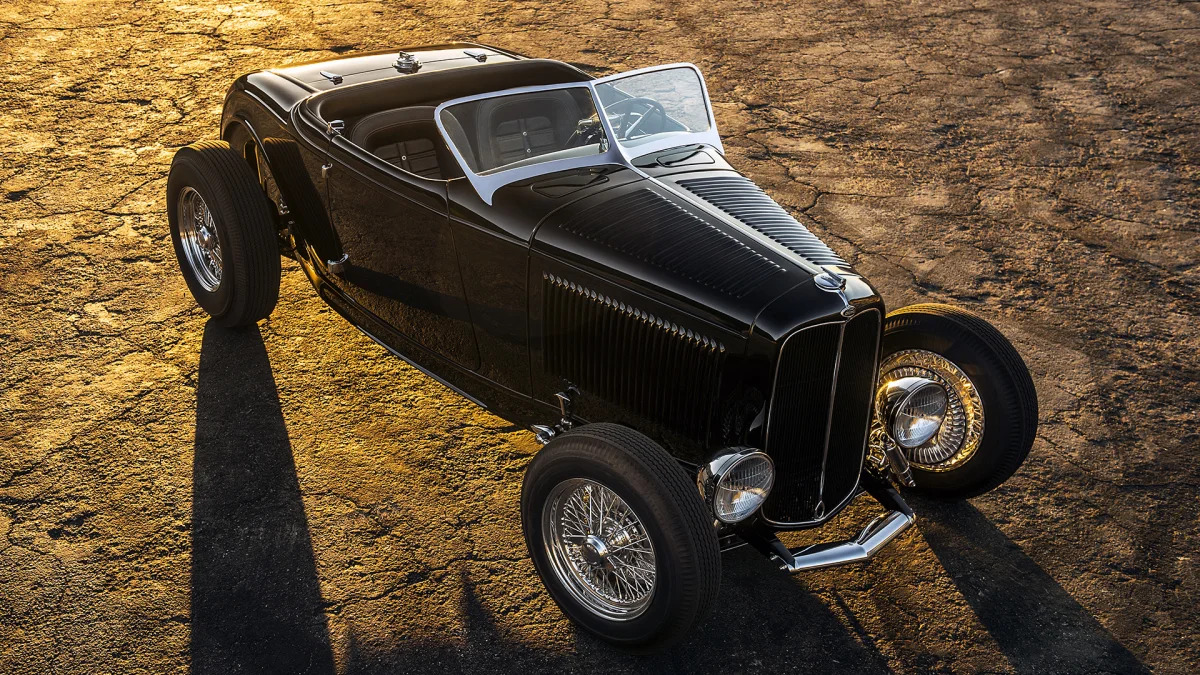









Sign in to post
Please sign in to leave a comment.
Continue